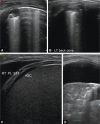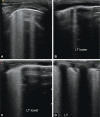Comparison of Efficacy of LUS and CXR in the Diagnosis of Children Presenting with Respiratory Distress to Emergency Department
- PMID: 32863640
- PMCID: PMC7435092
- DOI: 10.5005/jp-journals-10071-23459
Comparison of Efficacy of LUS and CXR in the Diagnosis of Children Presenting with Respiratory Distress to Emergency Department
Abstract
Introduction: Respiratory distress (RD) in children is a life-threatening condition. Delay in diagnosis has a deleterious effect on morbidity and mortality. The bedside lung ultrasound in emergency (BLUE) is a fast method that aims to accelerate the diagnosis with minimal radiological exposure. We targeted to evaluate the efficacy of BLUE protocol to speed and increase the precision of recognizing the cause of RD compared with chest X-ray (CXR) in the emergency department.
Materials and methods: A cross-sectional study on 63 children with RD attended the emergency of a tertiary, university-affiliated, pediatric medical center between January 2017 and January 2018.
Results: Most cases were males 52.4%. We designed to estimate the value of BLUE as a diagnostic tool for RD and comparing it with CXR. Pneumonia with or without pleural effusion was the main etiology of RD detected by BLUE in 47.7% of studied children, pulmonary edema in 22.2%, bronchiolitis and asthma in 17.4%, and pneumothorax in 12.7%. Lung ultrasound (LUS) was superior to CXR in the diagnosis of RD cause, and most cases, 47.7% were diagnosed with pneumonia with a sensitivity of 93.5% and specificity 96.9%.
Conclusion: Bedside lung ultrasound in emergency is an effective tool for identifying the cause of RD which is more sensitive and specific compared with CXR.
How to cite this article: Hegazy LM, Rezk AR, Sakr HM, Ahmed AS. Comparison of Efficacy of LUS and CXR in the Diagnosis of Children Presenting with Respiratory Distress to Emergency Department. Indian J Crit Care Med 2020;24(6):459-464.
Keywords: Bedside lung ultrasound in emergency protocol; Chest X-ray; Emergency; Pediatrics.
Copyright © 2020; Jaypee Brothers Medical Publishers (P) Ltd.
Conflict of interest statement
Source of support: Nil Conflict of interest: None
Figures
Similar articles
-
Lung ultrasound for diagnosis of pneumonia in emergency department.Intern Emerg Med. 2015 Oct;10(7):851-4. doi: 10.1007/s11739-015-1297-2. Epub 2015 Sep 7. Intern Emerg Med. 2015. PMID: 26345533
-
The Role of Lung Ultrasonography in Etiologic Diagnosis of Acute Dyspnea in a Resource Limited Setting.Bull Emerg Trauma. 2020 Apr;8(2):121-124. doi: 10.30476/BEAT.2020.46453. Bull Emerg Trauma. 2020. PMID: 32420398 Free PMC article.
-
Diagnostic Performance of 6-Point Lung Ultrasound in ICU Patients: A Comparison with Chest X-Ray and CT Thorax.Turk J Anaesthesiol Reanim. 2019 Aug;47(4):307-319. doi: 10.5152/TJAR.2019.73603. Epub 2019 Mar 12. Turk J Anaesthesiol Reanim. 2019. PMID: 31380512 Free PMC article.
-
Point-of-care lung ultrasound in detecting pneumonia: A systematic review.Can J Respir Ther. 2024 Jan 29;60:37-48. doi: 10.29390/001c.92182. eCollection 2024. Can J Respir Ther. 2024. PMID: 38299193 Free PMC article.
-
Current Trends in the Imaging Diagnosis of Neonatal Respiratory Distress Syndrome (NRDS): Chest X-ray Versus Lung Ultrasound.Cureus. 2024 Sep 20;16(9):e69787. doi: 10.7759/cureus.69787. eCollection 2024 Sep. Cureus. 2024. PMID: 39429372 Free PMC article. Review.
Cited by
-
The correlation between lung ultrasound scores and outcomes of high-flow nasal cannula therapy in infants with severe pneumonia.BMC Pediatr. 2024 Jan 16;24(1):51. doi: 10.1186/s12887-024-04522-7. BMC Pediatr. 2024. PMID: 38229006 Free PMC article.
-
Could lung ultrasound be a valid alternative to ionizing radiation or a complementary diagnostic choice in pediatric respiratory diseases?Transl Pediatr. 2024 Jul 31;13(7):1273-1278. doi: 10.21037/tp-24-36. Epub 2024 Jul 29. Transl Pediatr. 2024. PMID: 39144430 Free PMC article. No abstract available.
-
The utility of chest x-ray and lung ultrasound in the management of infants and children presenting with severe pneumonia in low-and middle-income countries: A pragmatic scoping review.J Glob Health. 2022 Dec 23;12:10013. doi: 10.7189/jogh.12.10013. J Glob Health. 2022. PMID: 36560909 Free PMC article.
-
The Role of Lung Ultrasound in the Management of the Critically Ill Neonate-A Narrative Review and Practical Guide.Children (Basel). 2021 Jul 24;8(8):628. doi: 10.3390/children8080628. Children (Basel). 2021. PMID: 34438519 Free PMC article. Review.
References
LinkOut - more resources
Full Text Sources
Research Materials
Miscellaneous




